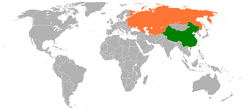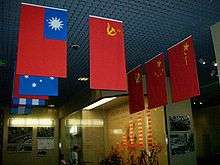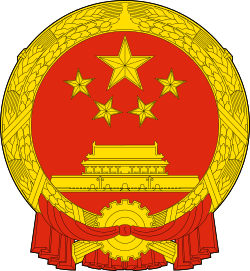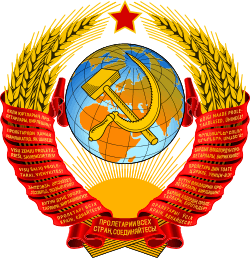Sino-Soviet relations
 |
|
China |
Soviet Union |
|---|---|

- For post-1991 relations, see Sino-Russian relations since 1991. See also History of Sino-Russian relations and History of foreign relations of the People's Republic of China.
Sino-Soviet relations (simplified Chinese: 中苏关系; traditional Chinese: 中蘇關係; pinyin: Zhōng Sū Guānxì; Russian: Советско-китайские отношения, Sovetsko-kitayskiye otnosheniya) refers to the diplomatic relationship between China and the various forms of Soviet Power which emerged from the Russian Revolution of 1917 to 1991, when the Soviet Union ceased to exist.
Country comparison
| People's Republic of China (China) |
Union of Soviet Socialist Republics (Soviet Union) | |
|---|---|---|
| Coat of Arms |  |
 |
| Flag |  |
 |
| Area | 9,640,011 km² (3,717,813 sq mi) | 22,402,200 km² (8,649,538 sq mi) |
| Population | 1,172,327,000 (1991) | 293,047,571 (1991) |
| Population Density | 140/km² (363/sq mi) | 13.1/km² (33.9 /sq mi) |
| Capital | Beijing | Moscow |
| Largest City | Shanghai | Moscow |
| Government | Unitary socialist one-party state | Unitary Marxist–Leninist one-party socialist state |
| Ruling political party | Communist Party of China | Communist Party of the Soviet Union |
| Legislature | National People's Congress | Supreme Soviet |
| Official languages | Mandarin | Russian |
| Other languages | Mongolian Tibetan Uyghur Zhuang |
Ukrainian Byelorussian Uzbek Kazakh Georgian Azerbaydzhani Lithuanian Moldavian Latvian Kirghiz Tadzhik Armenian Turkmen Estonian |
| Currency | Chinese yuan | Soviet ruble |
Russian Civil War and Mongolia
The Beiyang government in north China joined the Allied intervention in the Russian Civil War, sending forces to Siberia and North Russia beginning in 1918.
Mongolia and Tuva became contested territories. After being occupied by the Chinese General Xu Shuzheng in 1919, they came under the sway of the Russian White Guard General turned independent warlord, Ungern von Sternberg in 1920. Soviet troops, with support from Mongolian guerrillas led by Damdin Sükhbaatar, defeated the White warlord and established a new pro-Soviet Mongolian client state, which by 1924 became the Mongolian People's Republic.
The KMT, the CCP, the Chinese Civil War and the establishment of diplomatic relations
In 1921 the Soviet Union began supporting the Kuomintang (KMT), and in 1923 the Comintern instructed the Chinese Communist Party (commonly abbreviated as CCP) to sign a military treaty with the KMT. On May 31, 1924, the two governments signed an agreement to establish diplomatic relations, while the Soviet government renounced in that agreement all privileges granted to the Tsarist government in China.[1] But in 1926 KMT leader Chiang Kai-shek abruptly dismissed his Soviet advisers and imposed restrictions on CCP participation in the government. By 1927, after the conclusion of the Northern Expedition, Chiang purged the CCP from the KMT-CCP alliance, resulting in the Chinese Civil War which would last until 1949, a few months after the proclamation of the People's Republic of China, led by Mao Zedong. During the war the Soviets gave some support to the CCP, which in 1934 suffered a crushing blow when the KMT brought an end to the Chinese Soviet Republic, thus causing the CCP's Long March from Shaanxi. The Soviet Union tried and failed in an attempt to make the Hui hostile to China.[2]
Sino-Soviet conflict, 1929
The Sino-Soviet conflict of 1929 was a minor armed conflict between the Soviet Union and the Republic of China over the Manchurian Chinese Eastern Railway. The Chinese seized the Manchurian Chinese Eastern Railway in 1929, swift Soviet military intervention quickly put an end to the crisis and forced the Chinese to accept restoration of joint Soviet-Chinese administration of the railway.
Soviet Invasion of Xinjiang
The Soviet Union Red Army and their White Russian allies were severely mauled by the Republic of China 36th Division (National Revolutionary Army) which was composed of Muslims, when the Soviets attempted to seize Xinjiang.
Xinjiang War (1937)
The Soviet Union intervened again in Xinjiang in 1937.
Second Sino-Japanese War and World War II

In 1931, Japan invaded Manchuria and created the puppet state of Manchukuo (1932), which signaled the beginning of the Second Sino-Japanese War. In 1937, a month after the Marco Polo Bridge Incident, the Soviet Union established a non-aggression pact with the Republic of China. During the World War II period, the two countries suffered more losses than any other country, with China (in the Second Sino-Japanese war) losing about 30 million people and the Soviet Union 26 million.
Joint victory over Imperial Japan
On August 8, 1945, three months after Nazi Germany surrendered, and on the week of the American Atomic bombings of Hiroshima and Nagasaki, the Soviet Union launched the invasion of Manchuria, a massive military operation mobilizing 1.5 million soldiers against one million Kwantung Army troops, the last remaining Japanese military presence. Soviet forces won a decisive victory while the Kwantung suffered massive casualties, with 700,000 having surrendered. The Soviet Union distributed some of the weapons of the captured Kwantung Army to the CCP, who were still battling the KMT in the Chinese Civil War.
Ili Rebellion
While the Republic of China was concentrating on the Second Sino-Japanese War, the USSR supported Uyghur nationalists in their uprise in Xinjiang and set up Second East Turkestan Republic against Kuomintang. After the Chinese Communist Party defeated Kuomintang in 1949, USSR terminated support for the Second East Turkestan Republic.
The Soviets tried to spread anti-Chinese propaganda among minorities in Xinjiang, but this backfired when Uyghur mobs attacked White Russians and called for them to be expelled from Xinjiang.[3]
Pei-ta-shan Incident
Chinese Muslim forces fought against Soviet and Mongol troops in this incident.
Chinese Civil War and the People's Republic of China
Following 1946, the CCP was increasingly successful in the Civil War. On October 1, 1949, the People's Republic of China was proclaimed by Mao Zedong, and by May 1950 the Civil War had expelled the KMT from Mainland China but in control of Taiwan. With the creation of the People's Republic of China, the supreme political authority in the two countries became centred in two communist parties, both espousing revolutionary, Marxist–Leninist ideology: the Communist Party of China and the Communist Party of the Soviet Union.
After the establishment of the People's Republic of China, a sensitive issue which influenced the Sino-Soviet relationship emerged. As the condition of fighting with the Kwantung Army in the end of the Second World War, the Soviet Union got the use right of the China Far East Railway, the South Manchuria Railway, Lushun (also known as Port Arthur) and Dalian. These privileges were significantly important as the Asian strategies of the Soviet Union because the Port Arthur and Dalian were appropriate ice-free ports for the Soviet Navy, and the China Far East Railway and the South Manchuria Railway were the essential arterial communications which connected Siberia to the Port Arthur and Dalian. As Mao Zedong thought that the use right of China Far East Railway, the South Manchuria Railway, the Port Arthur and Dalian refers to Chinese state sovereignty, he required the Soviet Union to return these interests to China, and this was a crucial part of the Sino-Soviet Treaty of Friendship. Joseph Stalin initially refused this treaty, but finally made a great concession, and agreed with this treaty under the various stresses.[4] With this treaty, China acquired its state sovereignty, but the interests of the Soviet Union suffered a heavy loss, so the signing of the Sino-Soviet Treaty of Friendship marked the moment that the relationship between China and the Soviet Union came to the worst.
Since the Sino-Soviet Treaty of Friendship, the Soviet Union lost its naval bases in the Port Arthur and Dalian, the issue that Stalin had to face was to find a new ice-free port as the Soviet naval base. This issue supported Stalins reasoning to allow Kim Il-Sung to launch the Korean War.[4] However, both Kim Il-Sung and Stalin did not consider that the United States would intervene into that war immediately, if at all. Kim Il-Sung could not sustain the attack from the US Army. When Kim Il-Sung required military assistance from the Soviet Union and China, Mao agreed to send Chinese troops, but asked the Soviet Air Force to provide air cover. As the two leaders distrusted each other, Stalin agreed with sending Chinese troops to Korea, but refused to provide air cover.[5] Since without the air cover from the Soviet Union, Mao once considered that China did not send troops into Korea, and Stalin at one time decided to give up the Korea Peninsula.[5] After much cogitation, Mao solely sent Chinese troops into Korea on 19 October 1950 under an extremely hard Chinese economic and military situation. This activity ultimately changed the Sino-Soviet relationship. After 12 days of Chinese troops entering the war, Stalin allowed the Soviet Air Force to provide air cover, and supported more aid to China.[5] Mao sending Chinese troops to take part in the Korean War was followed by large-scale economic and military cooperation between China and the Soviet Union, and the friendly relationship of the two countries changed from titular to virtual. In one less known example of the Sino-Soviet military cooperation, in April–June 1952 a group of Soviet Tupolev Tu-4 aircraft were based in Beijing to perform reconnaissance missions on American fusion bomb tests in the Pacific.[6]
Sino-Soviet split
Thus, in the immediate years after the PRC was proclaimed, the Soviet Union became its closest ally. Soviet design, equipment and skilled labour was set out to help industrialize and modernize the PRC. But the extent of actual support, while not insignificant, fell well below Chinese expectations. In the 1960s, relations became deeply strained following the Sino-Soviet Split, culminating in the Sino-Soviet border conflict in 1969. Increasingly, the PRC began to consider the Soviet Union, which it viewed as Social imperialist, as the greatest threat it faced. In turn, overtures were made between the PRC and the US, such as in the Ping Pong Diplomacy and the 1972 Nixon visit to China.
The Soviet Union had encouraged Uyghurs to rebel against China.[7]
Post-Mao era and stabilizing relations
In 1976, Mao died, and in 1978, the Gang of Four were overthrown by Deng Xiaoping, who was to soon implement pro-market economic reform. With the PRC no longer espousing the anti-revisionist notion of the antagonistic contradiction between classes, relations between the two countries became gradually normalized. In 1979, however, the PRC launched the Sino-Vietnamese War, a failed invasion of Vietnam (which had, after a period of ambivalence, sided with the Soviet Union) in response to the Vietnamese invasion of Cambodia which overthrew the China-backed Khmer Rouge from power.
During the Sino-Soviet split, strained relations between China and the Soviet Union resulted in strained relations between China and the pro-Soviet Afghan communist regime. China and Afghanistan had neutral relations with each other during the rule of King Zahir Shah. When the pro-Soviet Afghan communists seized power in Afghanistan in 1978, relations between China and the Afghan communists quickly turned hostile. The Afghan pro-Soviet communists supported the Vietnamese during the Sino-Vietnamese War and blamed China for supporting Afghan anti-communist militants. China responded to the Soviet invasion of Afghanistan by supporting the Afghan Mujahideen and ramping up their military presence near Afghanistan in Xinjiang. China acquired military equipment from the United States to defend itself from Soviet attack.[8]
China moved its training camps for the Mujahideen from Pakistan into China itself. Hundreds of millions worth of anti-aircraft missiles, rocket launchers and machine guns were given to the Mujahideen by the Chinese. Chinese military advisors and army troops were present with the Mujahideen during training.[9]
Even though Soviet leader Mikhail Gorbachev went on to criticize the post-Maoist CCP when it allowed for PRC millionaires as having lost the socialist path, with the dissolution of the Soviet Union in the late 1980s and early 1990s, the Soviet Union itself turned to privatization.
Dissolution of the Soviet Union
Unlike that of the PRC, this was a much more extreme, highly unregulated form of privatization which resulted in massive losses to foreign speculators, near-anarchical conditions and economic collapse. Thus, in the post-Cold War period, while the Soviet Union remained vastly more developed (economically and militarily), in a systemic and deep way (i.e., the PRC in 1949 was less industrialized than Russia in 1914), the PRC emerged in a far more favourable and stable financial position. While the severe Soviet shortage of capital was new, Chinese economic and military underdevelopment was not. Nor was the PRC's desperate and ever-growing need for mineral resources, especially petroleum fuel, which the Soviet Union held in abundance in such Asiatic regions as western Siberia.
See also
References
- Dunnell, Ruth W.. 1988. “SOVIET SCHOLARSHIP ON MEDIEVAL CHINA, 1982-1987”. Bulletin of Sung and Yüan Studies, no. 20. Society for Song, Yuan, and Conquest Dynasty Studies: 137–42. http://www.jstor.org/stable/23497401.
- Richard R. Wertz. Sino-Soviet Relations Exploring Chinese history
Notes
- ↑ Text in League of Nations Treaty Series, vol. 37, pp. 176-191.
- ↑ Frederick Roelker Wulsin, Joseph Fletcher, Peabody Museum of Archaeology and Ethnology, National Geographic Society (U.S.), Peabody Museum of Salem (1979). Mary Ellen Alonso, ed. China's inner Asian frontier: photographs of the Wulsin expedition to northwest China in 1923 : from the archives of the Peabody Museum, Harvard University, and the National Geographic Society (illustrated ed.). The Museum : distributed by Harvard University Press. p. 49. ISBN 0-674-11968-1. Retrieved 2010-06-28.
- ↑ UNSUCCESSFUL ATTEMPTS TO RESEOLVE POLITICAL PROBLEMS IN SINKIANG; EXTENT OF SOVIET AID AND ENCOURAGEMENT TO REBEL GROUPS IN SINKIANG; BORDER INCIDENT AT PEITASHAN
- 1 2 Text in Shen Zhihua, 中苏关系史纲, 新华出版社,2007年,北京
- 1 2 3 Text in Shen Zhihua, China and the Dispatch of the Soviet Air Force: The Formation of the Chinese-Soviet-Korean Alliance in the Early Stage of the Korean War, in: The Journal of Strategic Studies, Vol. 33, No.2, pp. 211-230.
- ↑ "Pages from the diary of the retired Colonel Peter Vladimirovich Strunov" (in Russian). Airforce.ru.
- ↑ Muthiah Alagappa (1998). Muthiah Alagappa, ed. Asian security practice: material and ideational influences (illustrated ed.). Stanford University Press. p. 130. ISBN 0-8047-3348-1. Retrieved 2011-09-09.
- ↑ S. Frederick Starr (2004). S. Frederick Starr, ed. Xinjiang: China's Muslim Borderland (illustrated ed.). M.E. Sharpe. p. 157. ISBN 0765613182. Retrieved May 22, 2012.
- ↑ S. Frederick Starr (2004). S. Frederick Starr, ed. Xinjiang: China's Muslim Borderland (illustrated ed.). M.E. Sharpe. p. 158. ISBN 0765613182. Retrieved May 22, 2012.
